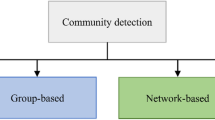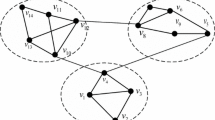Abstract
Searching for key nodes in social networks and clustering communities are indispensable components in community detection methods. With the wide application demand of detecting community networks, more and more algorithms have been proposed. Laplacian centrality peaks clustering (LPC) is an efficient and simple algorithm which is proposed on the basis of density peaks clustering (DPC) to identify clusters without parameters and prior knowledge. Before LPC is widely applied in community detection algorithms, some shortcomings should be addressed. Firstly, LPC fails to search for key nodes in networks accurately because of the similarity calculation method. Secondly, it takes too much time for LPC to calculate the Laplacian centrality of each point. To address these issues, a community detection algorithm based on Quasi-Laplacian centrality peaks clustering (CD-QLPC) is proposed after studying the advantages of Quasi-Laplacian centrality which can replace density or Laplacian centrality to characterize the importance of nodes in networks. Quasi-Laplacian centrality is obtained by the degree of each node directly, which needs less time than Laplacian centrality. In addition, a trust-based function is utilized to obtain the similarity accurately. Moreover, a new modularity-based merging strategy is adopted to identify the optimal number of communities adaptively. Experimental results show that CD-QLPC outperforms many state-of-the-art methods on both real-world networks and synthetic networks.








Similar content being viewed by others
References
Ghosh S, Halappanavar M, Tumeo A et al (2018) Distributed louvain algorithm for graph community detection. 2018 IEEE International Parallel and Distributed Processing Symposium (IPDPS):885–895
Zhang Z, Pu P, Han D et al (2018) Self-adaptive Louvain algorithm: Fast and stable community detection algorithm based on the principle of small probability event. Physica A 506:975–986
Dong J, Chen B, Liu L et al (2018) A degree-based distributed label propagation algorithm for community detection in networks. Proceedings of the 4th ACM SIGSPATIAL International workshop on safety and resilience:1–5
Ma T, Yue M, Qu J et al (2018) PSPLPA: Probability and similarity based parallel label propagation algorithm on spark. Physica A 503:366–378
Hu F, Zhu Y, Shi Y et al (2017) An algorithm Walktrap-SPM for detecting overlapping community structure. Int J Mod Phys B 31(15):1–22
Liu F, Wu J, Zhou C, et al. (2019) Evolutionary community detection in dynamic social networks. 2019 International Joint Conference on Neural Networks (IJCNN), pp.14–19
Liu F, Wu J, Xue S et al (2020) Detecting the evolving community structure in dynamic social networks. World Wide Web 23(2):715–733
Qin M, Jin D, Lei K et al (2018) Adaptive community detection incorporating topology and content in social networks. Knowledge-Based Syst 161:342–356
Bhih A, Johnson P, Randle et al (2020) An optimisation tool for robust community detection algorithms using content and topology information. J Supercomput 76(1):226–254
Zhang L, Pan H, Su Y et al (2017) A mixed representation-based multiobjective evolutionary algorithm for overlapping community detection. IEEE T Cybern 47(9):2703–2716
Ding X, Zhang J, Yang J et al (2018) A robust two-stage algorithm for local community detection. Knowledge-Based Syst 152:188–199
Gao Y, Zhang H, Zhang Y et al (2019) Overlapping communities from lines and triangles in complex networks. Physica A 521:455–466
Guo X, Su J, Zhou H et al (2019) Community detection based on genetic algorithm using local structure similarity. IEEE Access 7:134583–134600
Hu X, He W, Li L et al (2019) An efficient and fast algorithm for community detection based on node role analysis. Int J Mach Learn Cybern 10(4):641–654
Liu Z, Ma Y (2019) A divide and agglomerate algorithm for community detection in social networks. Inf Sci 482:321–333
Xu Y (2019) Community detection based on network communicability distance. Physica A 515:112–118
Zhang X, Zhou K, Pan H et al (2020) A network reduction-based multiobjective evolutionary algorithm for community detection in large-scale complex networks. IEEE T Cybern 50(2):703–716
Rodriguez A, Laio A (2014) Clustering by fast search and find of density peaks. Science 344(6191):1492–1496
Du M, Ding S, Xue Y et al (2019) A novel density peaks clustering with sensitivity of local density and density-adaptive metric. Knowl Inf Syst 59(2):285–309
Xu X, Ding S, Wang L et al (2020) A robust density peaks clustering algorithm with density-sensitive similarity. Knowledge-Based Syst 200:1–11
Xu X, Ding S, Du M et al (2018) GDCG: an efficient density peak clustering algorithm based on grid. Int J Mach Learn Cybern 9(5):743–754
Xu X, Ding S, Xu H et al (2019) A feasible density peaks clustering algorithm with a merging strategy. Soft Comput 23(13):5171–5183
Du M, Ding S, Jia H (2016) Study on density peaks clustering based on k-nearest neighbors and principal component analysis. Knowledge-Based Syst 99:135–145
Ding S, Du M, Sun T et al (2017) An entropy-based density peaks clustering algorithm for mixed type data employing fuzzy neighborhood. Knowledge-Based Syst 133:294–313
Xu X, Ding S, Shi Z (2018) An improved density peaks clustering algorithm with fast finding cluster centers. Knowledge-Based Syst 158:65–74
Du M, Ding S, Xu X et al (2018) Density peaks clustering using geodesic distances. Int J March Learn Cybern 9(8):1335–1349
Xu M, Li Y, Li R et al (2019) EADP: An extended adaptive density peaks clustering for overlapping community detection in social networks. Neurocomputing 337:287–302
Deng Z, Qiao H, Gao M et al (2019) Complex network community detection method by improved density peaks model. Physica A 526:1–13
Bai X, Yang P, Shi X et al (2017) An overlapping community detection algorithm based on density peaks. Neurocomputing 226:7–15
Zhou K, Pan Q, Martin A (2018) Evidential community detection based on density peaks. 5th Biennal International Conferences on Belief Functions-Theory and Applications (BELIEF) 11069:269–277
Lu H, Zhao Q, Sang X et al (2020) Community detection in complex networks using Nonnegative matrix factorization and density-based clustering algorithm. Neural Process Lett 51(2):1731–1748
Wang M, Zuo W, Wang Y (2016) An improved density peaks-based clustering method for social circle discovery in social networks. Neurocomputing 179:219–227
Zhou X, Liu Y, Wang J et al (2017) A density based link clustering algorithm for overlapping community detection in networks. Physica A 486:65–78
Abulaish M, Bhat I et al (2020) Scaling density-based community detection to large-scale social networks via MapReduce framework. J Intell Fuzzy Syst 38(2):1663–1674
Mohotti WA et al (2018) Corpus-based augmented media posts with density-based clustering for community detection. IEEE International Conference on Tools with Artificial Intelligence (ICTAI):379–386
Liu D, Su Y, Li X et al (2018) A novel community detection method based on cluster density peaks 6th CCF. International Conference on Natural Language Processing and Chinese Computing (NLPCC) 10619:515–525
Yang X, Zhu Q, Huang Y et al (2017) Parameter-free Laplacian centrality peaks clustering. Pattern Recogn Lett 100:167–173
Yang X, Jin L et al (2018) Laplacian centrality peaks clustering based on potential entropy. IEEE Access 6:55462–55472
Qi X, Fuller E, Wu Q et al (2012) Laplacian centrality: A new centrality measure for weighted networks. Inf Sci 194:240–253
Ma Y, Cao Z, Qi X et al (2019) Quasi-Laplacian centrality: A new vertex centrality measurement based on Quasi-Laplacian energy of networks. Physica A 527:1–12
Li H, Su L (2015) A note on the second smallest eigenvalue of the normalized Laplacian of a graph. Util Math 98:171–181
Kosub S (2019) A note on the triangle inequality for the Jaccard distance. Pattern Recogn Lett 120:36–38
CN Z, Lausen G (2004) Analyzing correlation between trust and user similarity in online communities. 2nd International Conference on Trust Management 2995:251–265
Jin Z, Xu P (2018) An adaptive community detection algorithm of density peaks clustering. Journal of Harbin institute of technology 50(5):44–51
Baht S, Abulaish M, HOCTracker (2015) Tracking the evolution of hierarchical and overlapping communities in dynamic social networks. IEEE Trans Knowl Data Eng 27(4):1019–1031
Zachary W (1997) An information flow model for conflict and fission in small groups. J Anthropol Res 33(4):452–473
Lusseau D, Schneider K, Boisseau O et al (2003) The bottlenose dolphin community of doubtful sound features a large proportion of long-lasting associations. Behav Ecology Sociobiol 54(4):396–405
Girvan M, Newman M, Community structure in social and biological networks. Proc Natl Acad Sci, 99 (12) (2002), pp.7821–7826
Gleiser PM, Danon L (2003) Community structure in jazz. Adv Complex Syst 6(4):565–573
Sun L, Bao S, Ci S et al (2019) Differential privacy-preserving density peaks clustering based on shared near neighbors similarity. IEEE Access 7:89427–89440
Amelio A, Pizzuti C (2015) Is normalized mutual information a fair measure for comparing community detection methods? IEEE/ACM International Conference on Advances in Social Networks Analysis and Mining (ASONAM), pp.1584–1585
Xiang J, Hu T, Zhang Y et al (2016) Local modularity for community detection in complex networks. Physica A 443:451–459
Haq N, Moradi M, Wang Z et al (2019) Community structure detection from networks with weighted modularity. Pattern Recogn Lett 122:14–22
Blondel V, Guillaume J et al (2008) Fast unfolding of communities in large networks. J Stat Mech -Theory Exp, 10 2008:p10008
Lancichinetti A, Fortunato S, Radicchi F (2008) Benchmark graphs for testing community detection algorithms. Phys Rev E 78(4):1–5
Acknowledgements
This work is supported by the National Natural Science Foundation of China under Grant no.61976216, and no.61672522.
Author information
Authors and Affiliations
Corresponding author
Additional information
Publisher’s note
Springer Nature remains neutral with regard to jurisdictional claims in published maps and institutional affiliations.
Rights and permissions
About this article
Cite this article
Shi, T., Ding, S., Xu, X. et al. A community detection algorithm based on Quasi-Laplacian centrality peaks clustering. Appl Intell 51, 7917–7932 (2021). https://doi.org/10.1007/s10489-021-02278-6
Accepted:
Published:
Issue Date:
DOI: https://doi.org/10.1007/s10489-021-02278-6




